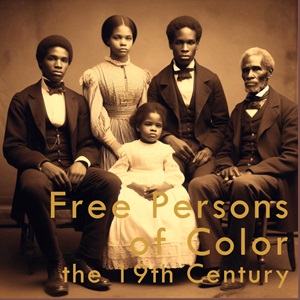

 |
 |
|
Study Areas Free Persons of Color |
Harrisburg CemeteryBlack History Perspectives Tour
|
|
Tour Stop 1: Richard J. Haldeman, Racist Politics in a Volatile AgeBrought up in a powerful and influential Harrisburg family, Richard Jacob Haldeman stood to take over an extensive business empire built by his father, Jacob Haldeman. The elder Haldeman built up an iron making business in Cumberland County from money borrowed from his entrepreneur father, expanded his operation with rolling and slitting mills, and supplied iron to the Federal arsenal at Harpers Ferry during the War of 1812. A shrewd businessman who understood the importance to local manufacturers of bridging the Susquehanna River between Harrisburg and Cumberland County, and the importance of financial support for such a project, Jacob Haldeman served as an organizer and early director of both the Harrisburg Bridge Company and the Harrisburg Bank. Putting his profits from iron making into land, Haldeman bought up local farms during an economic downturn, and in 1830 moved to Harrisburg. In Harrisburg, Jacob Haldeman continued his involvement with local institutions and enterprises, serving as president and longtime director of the Harrisburg Bank. He held the same positions with the Harrisburg Bridge Company and was a founding partner of the Harrisburg Car Works. He also invested in the newly-formed Dauphin Deposit Bank and the Harrisburg Cotton Mill. His son, Richard Jacob, whose substantial tomb is pictured above, also held investments in the Harrisburg Bank and Harrisburg Bridge Company, although his involvement with those companies was not as close as his father's; Richard never served on the board of directors of either concern. Richard attended and graduated from Yale, studied at the universities of Berlin and Heidelberg, and later served in the United States legations in Paris, St. Petersburg and Vienna. In the mid-1850's he took an interest in newspaper editing, bought the Democratic newspaper the Patriot and edited it until 1860. It was during this time that his interest turned to politics and he became heavily involved in Pennsylvania's Democratic party, serving as a delegate to the 1860 Democratic National Conventions in Baltimore and Charleston. He was elected a Representative from Pennsylvania to the U.S. Congress, serving two terms, from 1869-1873, after which he retired to the life of a gentleman farmer on his family's Cumberland County farm. Most biographical sketches of Richard J. Haldeman give only the details above, none of which relates directly to African American history. It is in the area of Richard Haldeman's political activities that we find relative material. The election of 1860 was particularly vicious in regard to racial issues because it was dominated by arguments over the legitimacy of slavery. The Democratic party was facing its first real challenge from Republicans who, though split among various factions, seemed united behind the anti-slavery banner. Haldeman, as Executive Committee Chairman of the National Democratic Union Club of Harrisburg, authored an address in March 1860 "to the Democracy of Pennsylvania" with the title "African Slavery Regarded From an Unusual Standpoint." This address was subtitled "Territorial Abstractions Ignored as Now Immaterial, and a More Radical Issue Raised." In the address, Haldeman warned of the "black cloud of Abolitionism" that has spread "from behind the hills of New England," and into which "ultra Abolitionism" the Republican party has fallen. He wrote "We discover the secret of it to consist in that vague belief in the equality of all races of men, which lies at the basis of the Republican party...their argument is based upon the assumption that the negro is fit for liberty and ought to have it." Haldeman then proposes that the Democrats challenge the Republicans on the issue of racial equality itself, rather than argue constitutional issues: Now the Democratic party has never met them squarely in the front; on the contrary, we have interposed the Constitution between the foe and ourselves; we have appealed to the compact between equal sovereign States; we have pointed to the compromises of that instrument, but we have never undertaken to show that the fundamental ideas of the Republican party are absolutely false, both in theory and in experiment.It is here that Haldeman delves into racist propaganda, undertaking a history of conflict in the world, seeing all wars of the world as wars between races or subdivisions of races. He writes: Thus we might go over the whole world, showing that races of nearly kindred blood ruled, the one over the other, but it is unnecessary. These different races have been so commingled in the United States that we have merely a struggle between all the branches of the great Caucasian family on the one hand, and the African race on the other--between the highest and lowest races of the earth. But the subject is with us much simplified, for it is between the white race and the black.To bolster his argument that Africans were "the lowest race," he cites a very flawed and ethnocentrically skewed historical view of civilization's benchmarks, noting: But rom none of these [other civilizations] did the black race absorb learning or the arts. It left no trace behind it in works beneficial to the human family; and if we follow the path which it took in its southward march, until we reach the highest peak in the Abyssinian mountains, to then turn our gaze northward, we can see nothing which the African has added to the stock of human learning; not an iota which it has bequeathed for the advancement of the human race; not the faintest trace of an addition to the happiness or comfort of mankind which it has made. If we cast our gaze to the south, we shall behold at least fifty millions of negroes sunk in the profoundest ignorance and barbarism.Then Haldeman plays his trump card, playing on white fears of miscegenation, and laying the blame on abolitionist and Republican views: Now the lecture rooms of the North ring with the most classical appeals in behalf of the African and against their Caucasian masters. Wendell Phillips preaches not only the equality of all races, but the equality of sexes; and he seems to be looking forward to a millennium, when all men and all women shall hug and kiss under the broad banner of "liberty, fraternity and equality."In the end, his address comes down to the ugliest of racist propaganda. These ideas of African Americans as witless, servile barbarians, dependant upon whites for direction and support, if not outright mastery, would be promulgated through the daily Democratic newspapers of Harrisburg and other northern papers through the 1870's, and beyond. Haldeman's role as a newspaper editor, however brief, lent credence to these views, and his position in Harrisburg society, with banking ties and extensive real estate holdings, gave him the means to put these views into practical usage.
|
||
Afrolumens Home Page | Enslavement | Underground Railroad | 19th Century | 20th Century
Original
material on this page copyright 2024 Afrolumens Project.
The url of this page is https://www.afrolumens.com/rising_free/hbgcem02.html